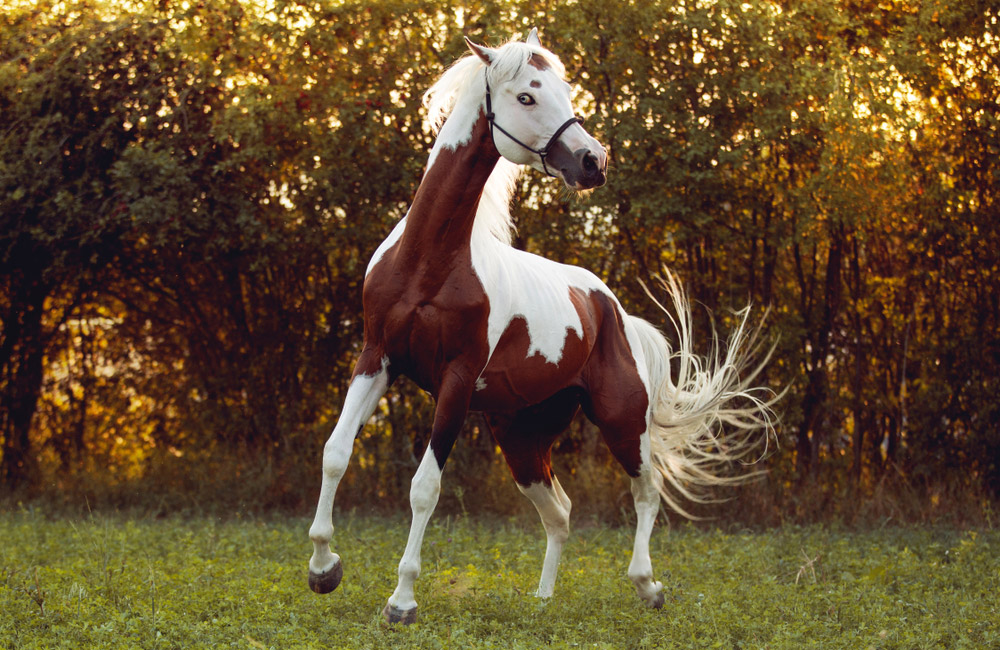
The American Paint Horse is a beloved breed whose colorful coat pattern is easy to recognize. With origins tracing back to the days of the Old West, this breed has enchanted horse lovers worldwide. From $5,000 to $10,000 – the cost of a young American Paint Horse can vary depending on the age, training, and pedigree.
Let’s check interesting facts and characteristics of American Paint Horses.
What Is a Paint Horse?
The American Paint Horse originated in the United States. That’s a horse breed that features white spottings on dark coat color. The American Quarter Horse and Thoroughbred took part in developing the Paint Horse. American Paint Horses are commonly used in reining, pleasure riding, and show jumping.
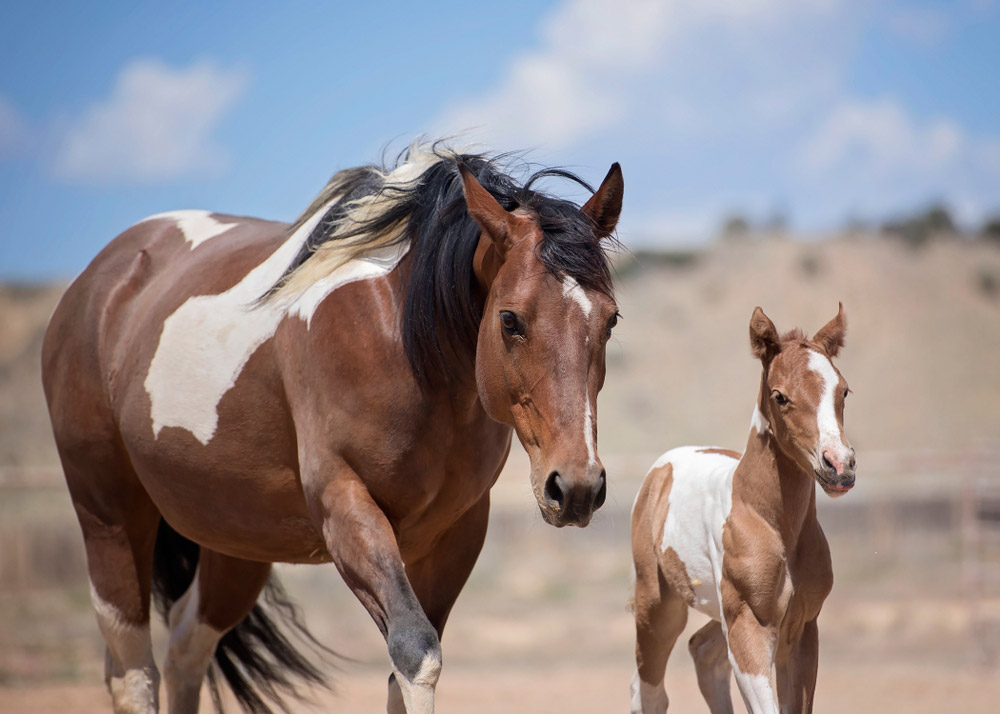
American Paint Horse History
In the 1500s, Paint Horses were brought to North America by Spanish conquistadors. Such horses as the American Quarter Horse and Thoroughbred have a common ground with the American Paint horse in their pedigree. Besides, the equines may have bloodlines for Arabian and Andalusian Horses as well. Hernando Cortes, a Spanish conquistador, is believed to bring the first Paint stallion to North America. And the Paint Horse breed population has begun.
At that time, most Paint Horses were free-roaming horses like the Mustang Horse. Native Americans adopted the Paints to use them as working and trail horses. These are brilliant stock horses that are ideal for working with livestock.
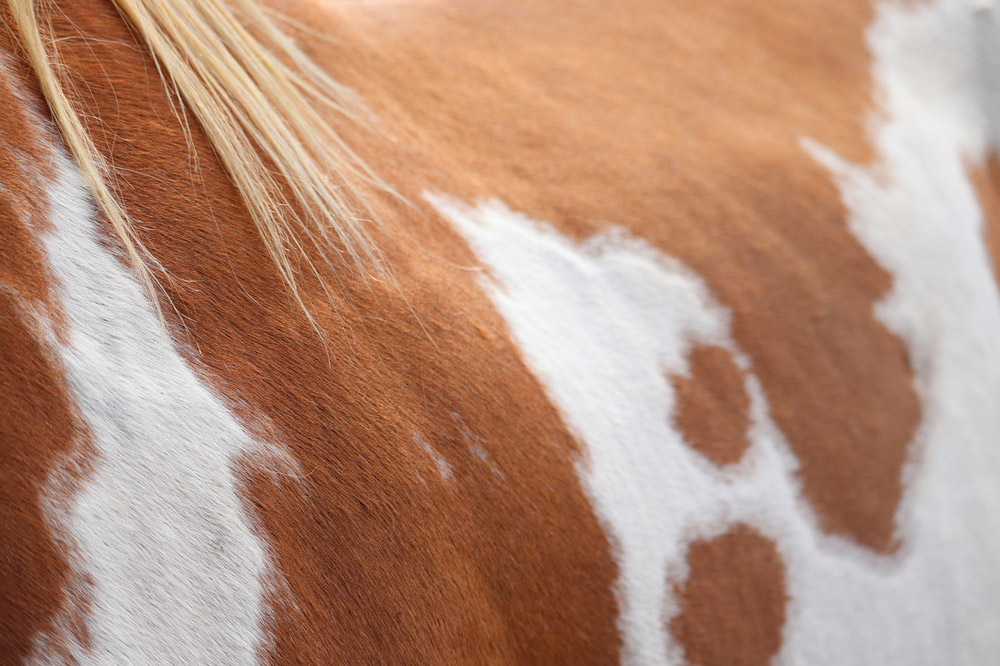
The Paint breed has become a rapidly growing North American equine. The breed was of great interest for its excellent body type, fascinating color patterns, and friendly tempo.
The British used Thoroughbreds to partake in a gene pool and develop a working horse with Paint Horses. It led to occurring equines with either spotted or solid-color coats.
The American Paint Horse Association
There was also a gene pool that included American Quarter Horses until 1940. That year the American Quarter Horse Association excluded all Paints from their registry. However, that didn’t stop the horse crossbreeding. The American Paint Quarter Horse Association and the American Stock Horse Association occurred.
In 1965, those associations teamed up to form the American Paint Horse Association (APHA). Nowadays, the APHA holds the Paint breed’s registry. The APHA settles in Fort Worth, Texas.
To get into the Regular Registry of the American Paint Horse Association, the horse must derive from a stock horse associated with one of the following organizations: APHA itself, U.S. Thoroughbred Registry (The Jockey Club), or the American Quarter Horse Association (AQHA). One or both parents must be a registered American Paint Horse. A solid-colored horse goes to another registry specially created for solid-paint bred horses.
The American Quarter Horse Association didn’t allow to register cropouts. These are horses with excessive white markings. It was believed such equines could produce foals with the lethal white syndrome (LWS) over time. The prohibition was called “the white rule.”
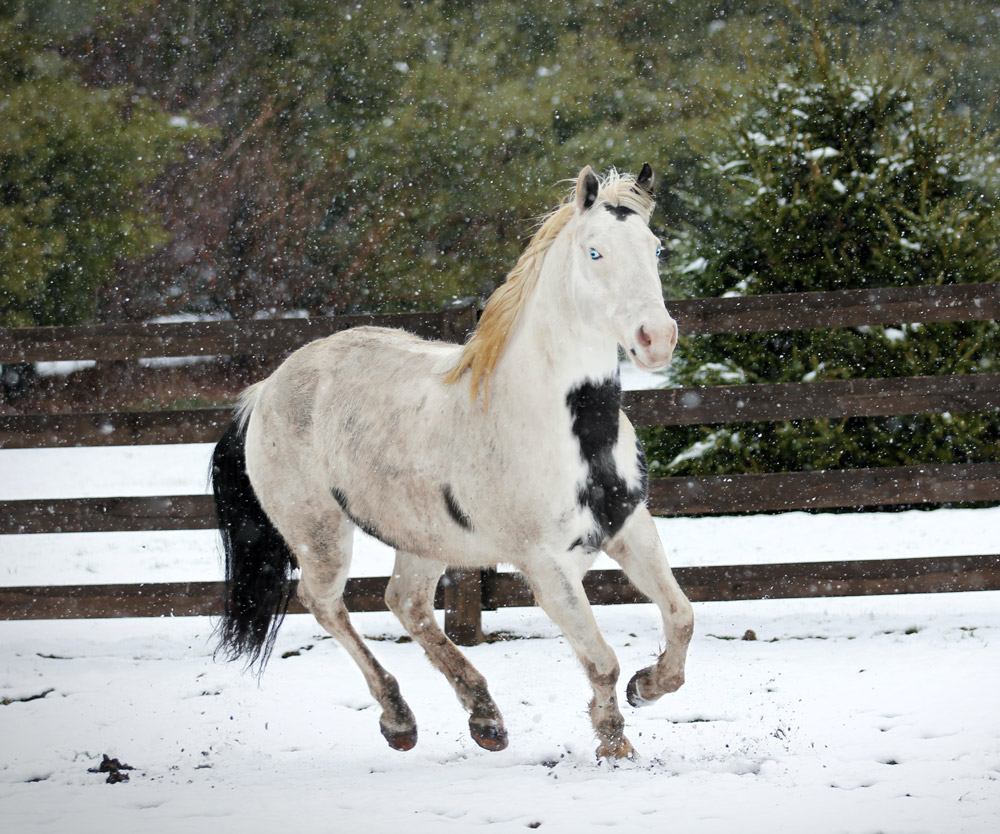
The tobiano, a white spotting pattern common in pinto horses, can occur in the case both parents carry this gene. If one parent has no tobiano, the foal won’t carry the gene. And the Thoroughbreds were such horses that were used in crossbreeding.
However, the Thoroughbred can carry another white color marking called sabino. And the Spanish mustang, an ancestor of the Quarter horse, carries the overo pattern. Thus, mating two equines of solid coat colors could produce a spotted foal. That’s in the case these parents carry such genes. Moreover, both solids may carry the LWS gene as well. As a result, a test for LWS has been developed. And the white rule was canceled.
The APHA registers equines with tobiano, overo, sabino, and tovero coat patterns. Some of them are solids that carry the Pinto breed bloodline. They allow pure and crossbreeding. This includes a combination of Paint to Thoroughbred and Paint to Quarter Horse.
The American Paint Horse Association also holds a program for juniors (AjPHA). The youth has the same membership benefits. They can take part in APHA performance competitions and programs. Besides, the AjPHA offers a range of activities to bond the ties among young equestrians.
There are cases when a horse is registered in three organizations at a time. Living Large is a horse that passes the Quarter horse registration along with the Pinto Horse Association (PHA) and the Paint Horse registration. This is due to the horse’s conformation and enough color to pass the last two registries.
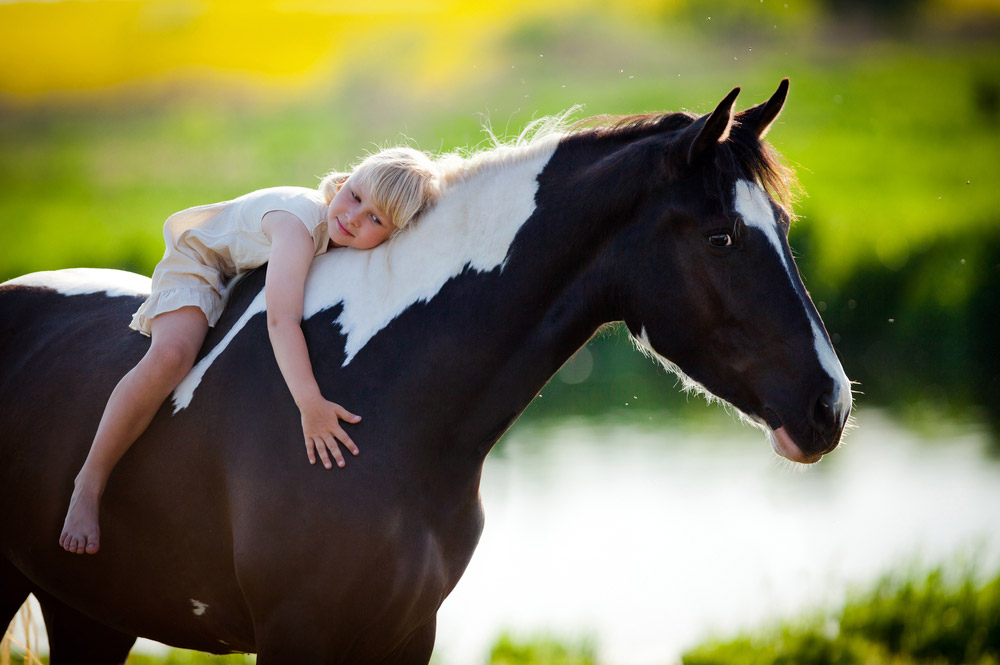
American Paint Horse Temperament
People love American Paint Horses for their friendly temperament. Such equines are easy-going and sociable. As these are herd animals, Paints are sociable equines that enjoy their owner’s attention. That’s why such a horse can be used as a family pet.
The American Paint Horse is highly intelligent. They are aptitude for learning new tricks. Training such horses is rewarding. They are fast, powerful, and agile. Riders commonly use Paint Horses in reining, barrel racing, and trail riding. They can withstand a heavy workload.
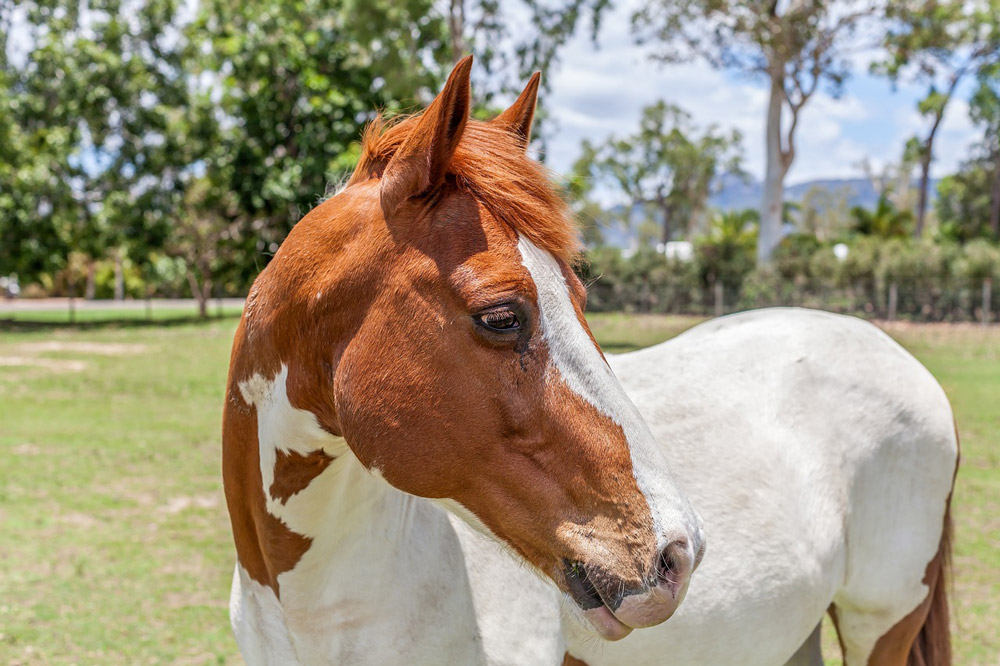
American Paint Horse Characteristics
As for the conformation, the Paint Horse features its coat color. It’s a combination of pinto spotting and dark patches. The equine was crossbred with the American Quarter Horse. This resulted in inheriting the distinguished muscular body and wide chest. The paint horse breeding is still questioned about the coat color inheritance. Because when breeding stock paints, not all foals become colored. Equines come with unique coat patterns that are not %100 predictable.
The breed stands out with a great sense of balance. Hence it’s the best horse for Western disciplines like barrel racing. Speaking of the color patterns, the typical Paint Horse has a set of dark and light spots on the coat.
The Paint breed has a strong muscular body, alert ears, and a long neck. The hindquarters are massive. The coat has huge patches all over the body. The low gravity centers make them good at balancing.
The Paint Horse height is 14 to 16 hands tall on average. Those equines that have a Thoroughbred bloodline are typically taller. The Paint Horse weight is 950 to 1,200 pounds on average. It’s a wee heavier than an average light horse breed.
Paint Horses live up to 30 years. That’s pretty solid.
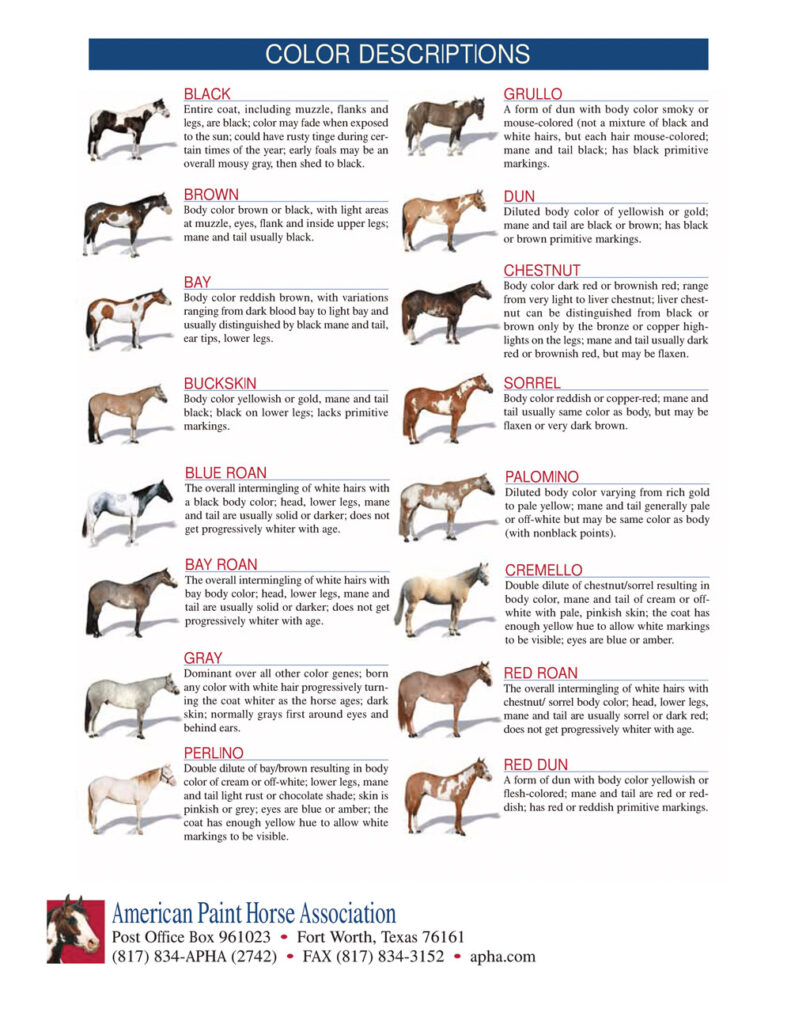
American Paint Horse Colors
Paint Horses have usually big white patches all over the body. The natural Paint marking is usually surrounded by a blue contour line. That’s a result of many color patterns. The basic coat color can be different. Including chestnut, black, bay, and palomino. American Paints may also carry a grey gene, and their hair will whiten over time. But still retaining pigmented skin underneath indicated the Paint horse pattern. The mix of markings is so different and unique, that there are no two horses of the same coat patterns.
The common markings for the American Paint Horse include tobiano, overo, and tovero.
- Tobiano. It’s the most common pinto pattern. It’s characterized by the white line along the spine with marks between the withers and on the dock of the horse’s tail. The head is usually solid with white markings like the star, strip, or snip. Besides, the legs are also white.
- Overo. It features unconventional white patches across the horse’s body. The back is usually of a solid color. There may be white stockings on the legs. The horse’s face has white markings as well.
- Tovero. It’s a combination of tobiano and overo markings. That means tovero horses may have different spotting patterns on the coat at once. Typically they have dark spots on the face, ears, and dock. The eyes are blue on a dark head, while the basic color is white.

How Much Does a Paint Horse Cost?
The American Paint Horse price is $5,000 on average. The range may differ due to the equine’s characteristics. They include the horse’s gender, age, color, health, pedigree, and training experience. If you’re looking for an APHA Registered Paint Horse that is well-trained, the price goes up to $10,000 and more.
Before buying a Paint Horse, get it tested. Check the horse’s behavior when it’s tacked, mounted, and ridden under a saddle. Ask to put on some gear like a saddle and bridle in front of you. So you can observe the animal’s reaction. Find out everything about the horse condition and health issues that are likely to occur in the breed.
Pinto vs Paint Horse – What’s the Difference?
Some people may confuse a pinto horse vs paint horse breeds. The truth is that pinto is referred to as a color pattern. While the Paint Horse is a horse breed. Thus, a pinto horse can be of any breed. The common pinto patterns include tobiano, tovero, and overo patterns.
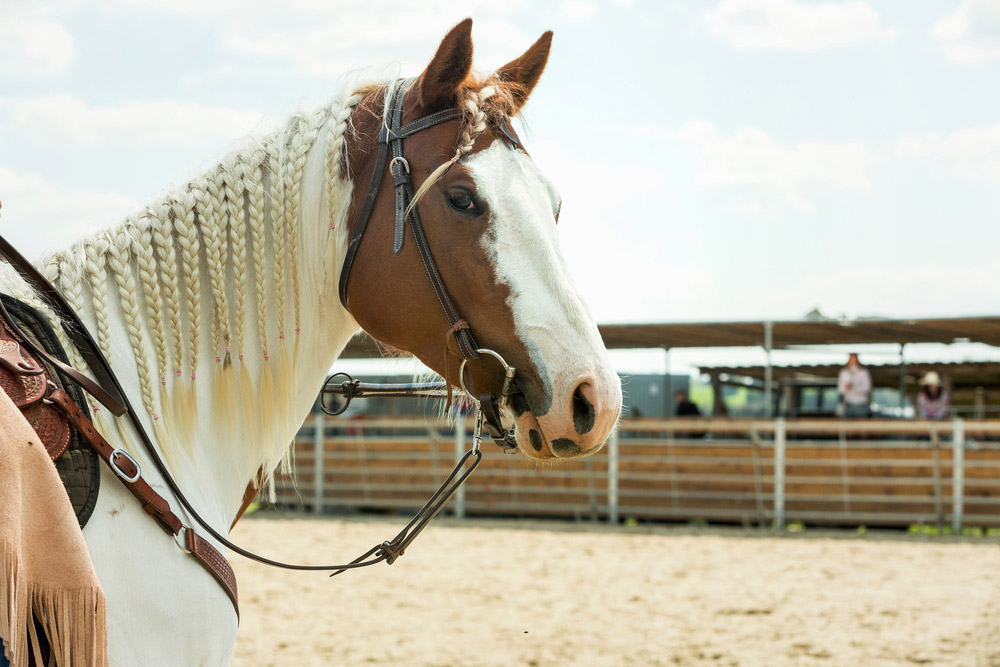
American Paint Horse Facts and Price Revealed
The American Paint Horse is a favorite of many horse owners and riders. The equine features a friendly and calm temperament. Paints have a tremendous coat color. It includes white patches on a solid color. The markings of these colorful stock horses can be spread differently.
The modern Paint breed costs around $5,000. Registered and experienced equines typically have a higher price. The American Paint Horse is versatile in use. It can work hard on your property and partake in horse shows. Once you get a Paint Horse, you’ll end up having a top-notch companion.
Image Source: press.apha.com, shutterstock.com, unsplash.com, pixabay.com.
